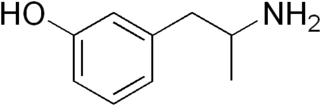ChemSpider is a freely accessible online database of chemicals owned by the Royal Society of Chemistry. It contains information on more than 100 million molecules from over 270 data sources, each of them receiving a unique identifier called ChemSpider Identifier.

Cafedrine, sold under the brand name Akrinor among others, is a chemical linkage of norephedrine and theophylline and is a cardiac stimulant and antihypotensive agent used to increase blood pressure in people with hypotension. It has been marketed in Europe, South Africa, and Indonesia.

Gepefrine, also known as 3-hydroxyamphetamine or α-methyl-meta-tyramine and sold under the brand names Pressionorm and Wintonin, is a sympathomimetic medication used as an antihypotensive agent which has been marketed in Germany.

Thozalinone (USAN) is a psychostimulant that has been used as an antidepressant in Europe. It has also been trialed as an anorectic. Thozalinone is described as a "dopaminergic stimulant", and likely acts via inducing the release of dopamine and to a minimal extent norepinephrine; similar to analogue pemoline, it is reportedly devoid of abuse potential unlike other dopaminergic psychostimulants.

Acecarbromal (INN), also known as acetylcarbromal and acetyladalin, is a hypnotic and sedative drug of the ureide (acylurea) group discovered by Bayer in 1917 that was formerly marketed in the United States and Europe. It is also used in combination with extract of quebracho and vitamin E as a treatment for erectile dysfunction under the brand name Afrodor in Europe. Acecarbromal is structurally related to the barbiturates, which are basically cyclized ureas. Prolonged use is not recommended as it can cause bromine poisoning.

Amidephrine, or amidefrine, sold under the brand name Fentrinol among others, is a selective α1-adrenergic receptor agonist which is described as an adrenergic or sympathomimetic, vasoconstrictor, and topical nasal decongestant used to treat allergic rhinitis. It is used as the mesylate salt, which has the generic names amidefrine mesilate and amidephrine mesylate. The drug is a substituted phenethylamine derivative and is also known as 3-methylsulfonamidyl-β-hydroxy-N-methylphenethylamine. As of 2000, it remained marketed only in Austria.

Prednimustine, sold under the brand names Mostarina and Sterecyst, is a medication which is used in chemotherapy in the treatment of leukemias and lymphomas. It is the ester formed from two other drugs, prednisolone and chlorambucil. Rarely, it has been associated with myoclonus.

Chlorproethazine, sold under the brand name Neuriplege, is a drug of the phenothiazine group described as a muscle relaxant or tranquilizer which is or has been marketed in Europe as a topical cream for the treatment of muscle pain. It has been associated with photoallergic contact dermatitis.

Stenbolone is an anabolic–androgenic steroid (AAS) of the dihydrotestosterone (DHT) group which was never marketed. A C17β ester prodrug of stenbolone, stenbolone acetate, is used as an AAS for depot intramuscular injection under the brand names Anatrofin and Stenobolone.

Pholedrine, also known as 4-hydroxy-N-methylamphetamine and sold under the brand names Paredrinol, Pulsotyl, and Veritol among others, is a sympathomimetic drug used in topical eye drops to dilate the pupil. It can be used to diagnose Horner's syndrome.

Chloral betaine, also known as cloral betaine (INN), is a sedative-hypnotic drug. It was introduced by Mead Johnson in the United States in 1963. It is a betaine complex of trimethylglycine with chloral hydrate, which acts as an extended-acting formulation of chloral hydrate which is then metabolized into trichloroethanol, which is responsible for most or all of its effects.

Leptacline is a drug described as a respiratory stimulant that was never marketed. It has a similar chemical structure to various piperidine and piperazine psychostimulants.

Delanterone, also known as 1α-methylandrosta-4,16-dien-3-one, is a steroidal antiandrogen described as an anti-acne agent which was never marketed. The compound showed poor efficacy as an antiandrogen in vivo in animals, suggestive of low activity or a short terminal half-life, and likely in relation to this was not further developed. It was described and characterized in the literature in 1977.

Flumexadol (INN) is a drug described and researched as a non-opioid analgesic which was never marketed. It has been found to act as an agonist of the serotonin 5-HT1A and 5-HT2C receptors and, to a much lesser extent, of the 5-HT2A receptor. According to Nilsson (2006) in a paper on 5-HT2C receptor agonists as potential anorectics, "The (+)-enantiomer of this compound showed [...] affinity for the 5-HT2C receptor (Ki) 25 nM) [...] and was 40-fold selective over the 5-HT2A receptor in receptor binding studies. Curiously, the racemic version [...], also known as 1841 CERM, was originally reported to possess analgesic properties while no association with 5-HT2C receptor activity was mentioned." It is implied that flumexadol might be employable as an anorectic in addition to analgesic. Though flumexadol itself has never been approved for medical use, oxaflozane is a prodrug of the compound that was formerly used clinically in France as an antidepressant and anxiolytic agent.

Cloxotestosterone acetate, also known as testosterone 17β-chloral hemiacetal O-acetate, is a synthetic, injected anabolic–androgenic steroid (AAS) and an androgen ether and ester – specifically, the O-acetate ester of cloxotestosterone, the 17β-trichloro hemiacetal ether of testosterone. It is administered via intramuscular injection, as a 100 mg, 2 mL aqueous suspension and lasts 4 to 6 weeks with a single administration. The drug was first marketed in the early 1960s.

Flugestone acetate (FGA), sold under the brand name Cronolone among others, is a progestin medication which is used in veterinary medicine.

Furostilbestrol (INN), also known as diethylstilbestrol di(2-furoate) or simply as diethylstilbestrol difuroate, is a synthetic, nonsteroidal estrogen of the stilbestrol group related to diethylstilbestrol, that was never marketed. It is an ester of diethylstilbestrol and was described in the literature in 1952.

Stenbolone acetate, also known as 2-methyl-4,5α-dihydro-δ1-testosterone 17β-acetate or as 2-methyl-5α-androst-1-en-17β-ol-3-one 17β-acetate, is a synthetic, injected anabolic–androgenic steroid (AAS) and derivative of dihydrotestosterone (DHT) which has been marketed in Spain.

Spiroxasone is a synthetic, steroidal antimineralocorticoid of the spirolactone group which was developed as a diuretic and antihypertensive agent but was never marketed. It was synthesized and assayed in 1963. The drug is 7α-acetylthiospirolactone with the ketone group removed from the C17α spirolactone ring. Similarly to other spirolactones like spironolactone, spiroxasone also possesses antiandrogen activity.

Pirenperone (INNTooltip International Nonproprietary Name, USANTooltip United States Adopted Name, BANTooltip British Approved Name; developmental code names R-47456, R-50656) is a serotonin receptor antagonist described as an antipsychotic and tranquilizer which was never marketed. It is a relatively selective antagonist of the serotonin 5-HT2 receptors and has been used in scientific research to study the serotonin system. In the 1980s, the drug was found to block the effects of the lysergic acid diethylamide (LSD) in animals, and along with ketanserin, led to the elucidation of the 5-HT2A receptor as the biological mediator of the effects of serotonergic psychedelics.



















